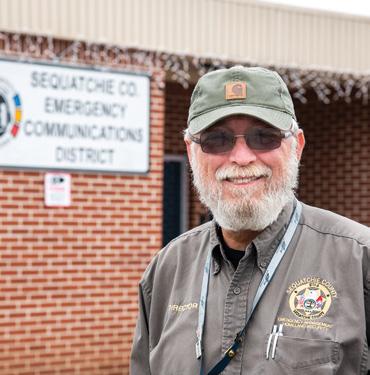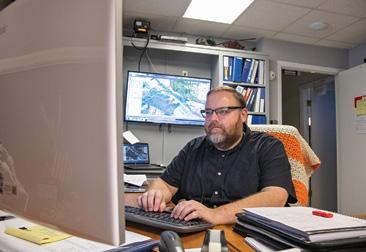
4 minute read
SEQUATCHIE 911
Sequatchie 911
Technology promotes safety
Story by LISA SAVAGE | Photography by MARK GILLILAND
When a hiker became lost on the rural mountain outside Dunlap, he called 911.
The man could not speak English. Dispatchers at Sequatchie County 911 could not understand him and did not know where he was or if he was hurt.
The call tested much of the 911 center’s capabilities that day, says Winfred Smith, the agency’s director.
“We used our internet with our mapping database to ping his location,” Smith says.
Meanwhile, other members of the telecommunications team used the agency’s language line to reach an interpreter to translate the call. “We had a lot of telephone calls going on that day,” Smith says.
The hiker was on Fredonia Mountain west of Dunlap. Rescue crews reached him quickly, and an emergency medical crew checked his condition. “Luckily, he wasn’t hurt, but it’s a perfect example of how valuable the technology we use is,” Smith says. “We want to do everything we can to provide the best services possible for our residents and for those visiting our area who might not speak English or know their location.”

Sequatchie County 911 director Winfred Smith.
ESTABLISHMENT OF 911 IN SEQUATCHIE COUNTY
The first 911 call in Sequatchie County came in April 2005, and many things have changed since then, Smith says. Sequatchie 911 started with director Mike Twitty and nine members of the board of directors, a few dedicated 911 lines and a couple of administration lines.
“Today, we have eight wireless trunk lines, two local 911 landlines and five administration nonemergency lines,” Smith says. The system uses an integrated computer-aided dispatch and mapping system, or CAD, and an integrated phone with a mapping system. There is also a text telephone device for the deaf, a recording system for all calls and RapidSOS, a resource that helps locate phone users.
“That’s the system the telecommunications team used to determine the location of the lost man,” Smith says. It’s an especially important system now with the increasing number of cellphone calls to 911.
“With the new technology and advances of cellphones, more and more people have gone to them, which makes it harder to track the caller or find them when there is an emergency,” Smith says. Technology that locates people using cellphones is expensive and changes quickly, so once the equipment is in place, it requires routine upgrades to keep up to date.
“Due to these factors, once we have new equipment in place, we are already budgeting and planning for future upgrades,” Smith says. “The safety of our citizens and those passing through is always our No. 1 concern.”
New text and video technology for 911 means upgraded equipment and increased personnel, and the costs increase steadily. “If we want to be able to provide the lines that 911 was intended to do, it all comes with a hefty price tag,” Smith says.
RECENT UPGRADES TO THE 911 SYSTEM
The CAD system provides better recording of calls and access to reference and statistical data archives. “Another great advantage to our CAD is that it offers text notifications to officers and responding units with valuable information, such as addresses of where they are needed,” Smith says.
An advanced mapping system was put in use at the same time as the CAD. It allows more accurate control over address accuracy, correcting potential issues that can cause delays in responses for fire, rescue and law enforcement agencies. “Map data, once gathered or corrected, is updated in real time at our 911 facility so that dispatchers can send responding units to calls in a timely manner, whereas before, we had to wait months to get new map updates on new roads,” Smith says.
BTC Fiber works with Sequatchie County 911 in establishing new addresses. “They send us the information with the person’s request for the new location, and we can tell them if the address is good, and then BTC Fiber can move on to install the services,” Smith says.
The 911 phone system recently underwent an upgrade to keep up with technology demands. “Not only are they used to simply answer a call, but it then needs to process data that shows us where the caller is, call-back numbers and more,” Smith says.
BTC Fiber’s upgrades help with efficiency in the Sequatchie 911 center. “That has made a world of difference in providing a backbone for our technology needs,” Smith says. “Everything is dependent on connections and having a dedicated fiber line that provides better redundancies versus older technologies, allowing us to advance our 911 center on a local and state level.”

Tommy White works as the information technology director for Sequatchie County 911.
SEQUATCHIE 911 CALLS SINCE 2005 A comparison of the number of calls shows a steady increase. 2005 total calls — about 4,000 2016 total calls — 26,194 2017 total calls — 36,905 2018 total calls — 45,641 January-September 2019 calls — close to 41,000

